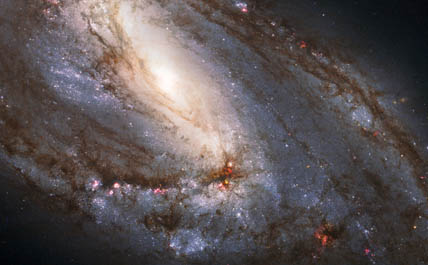This time each year, as Leo rises higher in the northern spring sky, backyard observers often zero in on a tidy trio of galaxies collectively known as the Leo Triplet. Its three majestic spirals — Messier 65, Messier 66, and NGC 3628 — lie about 35 million light-years away.

Roughly 100,000 light-years across, Messier 66 is the largest member of the Leo Triplet. It displays asymmetric spiral arms (dotted with pinkish star-forming regions) and an apparently displaced core. Click here for a larger version.
NASA / ESA / Hubble Heritage Team
Today the Hubble Heritage Project released a sweeping portrait of M66, which at 100,000 light-years across ranks as the group's largest member. Also known as NGC 3627, M66 spans a generous 9 arcminutes and glows at magnitude 8.9.
The Hubble view combines images taken by the Hubble Space Telescope in 2004 and 2009, along with a hydrogen-alpha image by amateur astrophotographer Rob Gendler to accentuate the red star-forming regions.
Astronomers are intrigued by this galaxy's unusual structure. Its asymmetric arms seem to be climbing up and out of the main disk, and the bright core is offset from the disk's center. These oddities are most likely due to the gravitational pull of the two neighboring galaxies.
According to the press release that accompanies the image, Messier 66 has hosted three supernovae since 1989, the latest one occurring in 2009. That's not surprising, given that the spiral arms teem with star-forming regions. (Compare this picture with an infrared view recorded in 2005 by the Spitzer Space Telescope.)
 0
0
Comments
You must be logged in to post a comment.